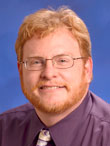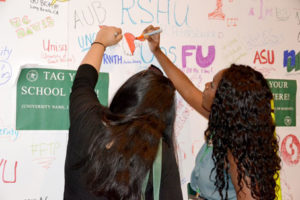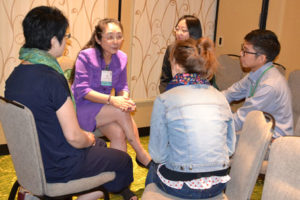As the Student Goes, So Goes Geography

This marks my last presidential column. Serving as President of the Association over the past year has been a true pleasure and honor. I have appreciated the opportunity to represent you and the discipline of geography. As someone who first began attending AAG meetings as a young graduate student, I never dreamed that one day I would be allowed to serve in this capacity. I would have never made it this far if not for the generous support of my academic programs, employers, mentors, and professional organizations. Thank you.
For my final remarks, I would like to come back to where it started for me and for so many of us—the student experience. Students are a large and important community within the AAG, constituting over 40% of membership. Recognizing this fact, the Association recently took the long overdue step of creating a Student Councilor position with full voting power on governance issues. Please join me in congratulating Sarah Stinard-Kiel of Temple University, who was just elected to serve in this role.
Our Association is increasingly interested in helping students take full advantage of their membership to reach their educational and professional aspirations. The recent New Orleans meeting saw career mentoring sessions, a networking happy hour, and other professional development discussions organized for students. These programs and the Student Councilor position signal a greater valuing of student voices and experiences than in the past, although there is still more that can and should be done.
In this column, I suggest that we might benefit from recognizing the capacity of students to be an important “compass” for assessing the current health and direction of geography and planning the future of the discipline and the AAG. The concept of compass, while a convenient and evocative metaphor for geographers, is also meant to capture the role that students already play and can play further in helping direct—rather than simply follow—the trajectory of the profession. There are a number of innovative student initiatives within geography that suggest that this leadership is already happening and that perhaps we need to rethink the traditional faculty-student divide in terms of disciplinary impact.
Foundational to my remarks is a firm belief that we need to create more opportunities to listen and respond to the views and concerns of our student members—building upon the strides underway in the AAG. This should be done at the level of individual programs, departments, and knowledge communities as well as the wider discipline and Association. As an early attempt at this process, I solicited feedback from undergraduate and graduate students within the AAG to several open-ended questions. It is impossible to do justice to the many wonderful responses received, but I wish to focus on a few key findings that might serve as points of intervention in the future.
I conclude this column with a “hail and farewell,” welcoming our new AAG President, paying tribute to our retiring Executive Director, and encouraging members to remain vigilant in supporting their colleagues and programs as we continue to move through an uncertain time.

Student as Compass
It might strike some as strange to think of students as a compass. After all, it is the job and responsibility of faculty and other experienced practitioners to guide, mentor and facilitate the learning and preparation process for students and early career professionals. As I argued in my first president’s column, effective mentorship of those new to the field is crucial to the health and sustainability of geography. But, I also suggested in that same column that mentorship must be a two-way process between junior and senior colleagues; any and all of us can learn from others regardless of rank, reputation, and years in the game.
In my own experiences as a department head and faculty member and in my travels as AAG President, I have seen numerous instances of students being important mentors and leaders in geography. The classroom is an obvious place where our students have a major guiding influence. Graduate student instructors are often well versed in active learning strategies and they increasingly ask their departments and programs for more organized opportunities to hone these skills. It is not by accident that some of our best recruiters of undergraduate student majors and minors are graduate student teachers. Given this fact, it is strange that AAG teaching-related awards appear to be restricted—at least in practice—to faculty instructors.
Students play a compass role in contributing to and protecting the intellectual vitality of geography. They are at the forefront of discovery, collaborating with faculty rather than merely assisting them. And, in many instances, students guide and drive research innovation themselves. They are frequent participants at academic conferences. I would dare to say that some of our AAG Regional Division meetings would struggle to survive if not for student attendees. Students —including undergraduates—have led the organization of their own geography meetings. One of the most impressive of these efforts is the South Dakota State Geography Convention, which will celebrate its 50th birthday in 2019. Student-led geography symposia are also found at Texas State University, University of Alberta, University College London, and my own University of Tennessee.
Students are also our compass in bringing key social and environmental problems and struggles to our attention and challenging us to do something about them. They are important voices of activism in a time when the stakes are high for effective science communication, evidence-based public debate, and social justice activism. The Youth Mappers Network is an impressive effort for cultivating student leaders who can leverage spatial data collection, analysis and visualization to support international development projects,crisis response, and public education about issues.
Students are proving to be passionate and determined advocates for the discipline. Students at the University of Nebraska-Lincoln recently protested a proposal to eliminate the school’s Geography Program. I have been told that this show of geography student support, along with a letters written by alumni, made a real difference in convincing administrators of the need to take Nebraska Geography off the cut list.
Other students, such as Sarah Diamond, have advocated for fairness and consistency in the graduate student experience in geography. In 2015, Sarah proposed to the AAG Council a “best practices” document to guide departments in their relationships with graduate students. Although the guidelines went unapproved by the Council, they hold promise in encouraging geography programs to develop policies to ensure that students receive, among other things, objective progress evaluations, access to formal processes for handling harassment, and clearly defined expectations regarding authorship and ownership of intellectual property.
Sarah’s proposal suggested a best practice worthy of adoption across the discipline—namely that students should be treated as “professionals and junior colleagues.” To see students in this way disrupts the traditional social hierarchy within education that has long contributed to faculty elitism and made students to feel inferior or second class. Thinking of students—even undergraduates to some degree—as early professionals assists us in fully recognizing and realizing the contributions they make in shaping the field. The idea of “student as professional and junior colleague” also communicates the high expectations that we have for this community to take seriously their work and studies in geography—all of which has a direct bearing on the future of our discipline.

Creating Moments to Listen and Act
The idea of the student as a compass is meant to recognize the value of paying greater attention to the power of students to define agendas and advance conversations within geography, but it is also about being responsive to the personal and professional needs of students as we work with them to plan and build programs, workplaces, and associations. Students are important compass bearings for faculty, reminders of why we teach and the importance of keeping curriculum, technology, and policies current as we prepare and support the new generation of professional geographers.
The prominence and relevance of our discipline is ultimately tied to the personal, social, and career well-being of students. Recent research encourages “timely and ‘actionable’ dialogue around how to better support” this sense of well-being of students. Scholarship by geographers, in particular, highlights the need for departments to create “caring collectives” that move beyond a focus only on the “individual actions of supervisors, or the individual quality of students.” Importantly, these collectives should address the non-academic as well as academic needs of students and mobilize a “distributed responsibility” for the care and support of students and wider disciplinary and academic communities.
One of the first ways of creating supportive and caring environments is to listen to students, using their feedback to think about where the discipline is going and where it needs to go in the future. I reached out several months ago to members of the AAG Graduate Student Affinity Group (GSAG) and the Undergraduate Student Affinity Group (USAG), asking them what anxieties they have about pursuing a career in geography, their perceptions about the effectiveness of their departments and the AAG as well as their ideas for new resources and tools to assist with their professional development. The comments of undergraduate and graduate students are collapsed because of space constraints, but clearly a full reporting would recognize that each group has its own unique perceptions and professional challenges. My hope is that even a brief summary of their comments might inform individual departments, the Council, and AAG staff as we support students and engage in further strategic planning and program development.
Perhaps expectedly, students expressed anxiety about landing employment after graduation, whether that is an academic position or one in another sector of the economy. In particular, among both undergraduate and graduate students, there is concern about finding non-academic employment, especially opportunities outside the area of GIS. There is also anxiety among students about geography being seen as less scientifically legitimate than other fields and hence hurting their employability. Graduate students especially worry about the neoliberal structure of universities, what they describe as a shrinking academic job market, and balancing the demands of work and life. Some students called for the creation of additional professional development seminars and workshops in their departments and at conferences to help them think through and strategize responses to these issues.
Students expressed satisfaction with and appreciation for their current programs and departments, but also note things that they would like to see improved. I used “departmental culture” in my initial prompt and students focused heavily on the things that compromise the culture in their programs. Problems identified include segregation and rivalries between sub-fields; a shortage of sufficient mentoring for students; a lack of engagement with the world outside academia; struggles to achieve gender diversity; and the difficulty in recruiting and retaining students and faculty of color. One respondent wanted her/his department to hold “town halls” in which students can air their concerns openly to faculty and administrators.
When asked about the effectiveness of the AAG, students gave high marks to the Association’s journals, annual meetings, public relations, policy involvement, free childcare at conferences, and networking opportunities. But respondents also had ideas about what needs to improve. Students would like to see AAG regional conferences more important and better attended. Several who provided feedback applauded the collective voice that Association has taken on political issues, but feel we can keep working in this area and make even stronger stands. Students appreciated the job resources provided by the AAG but they would also like to see a greater posting of non-academic jobs on its web site.
While students praised AAG’s ever expanding communication channels, they also asked that the Association use its organizational power to engage in more advertising of geography and getting geographers noticed by the public, other disciplines, and communities. A major concern among several students is the fact that geography remains a mostly white, male discipline. In the words of one respondent: “The AAG should find a way to productively engage this situation, including facilitating discussion on the degree to which it represents a problem, what the root causes are, and solutions.”
Finally, I asked undergraduate and graduate students about what additional resources, programs, or tools they would like to see developed by the AAG to assist them in their professional development and the overall health of geography. Their suggestions included: (1) periodic webinars on job searching, project management and consulting, and best practices in teaching, publishing, and writing grants; (2) podcast discussions with invited guests about timely research or the state of the discipline; (3) a regular column in the newsletter on career development for students and early-career professionals; (4) greater online job application materials, such as samples of cover letters and teaching philosophies specific to geography; (5) opportunities for conference attendees to get in touch with NGOs or other nonprofits in the city hosting the conference each year so that students can offer their services; and (6) more outreach to high schools and middle schools and greater pressure from AAG to have geography represented in state K-12 curriculum.
Many of the concerns identified by students mirror comments we receive from more senior colleagues, suggesting that students have a clear and quite sophisticated understanding of the challenges facing the discipline. Yet, students also identified concerns previously unknown to me. Importantly, they offered some “actionable” suggestions for supporting our student colleagues and improving the health of AAG and its geography programs.
Hail and Farewell
In July, Sheryl Luzzadder-Beach of the University of Texas at Austin begins her term as AAG President. Sheryl will do a fantastic job. She brings a great deal of vision, energy, and leadership experience to the post. Sheryl has a highly engaged and conscientious set of Regional, National, and Student Councilors with whom to work. Our Council meeting in New Orleans was especially productive and marked by many hours of discussion, debate, and decision-making.
Like me, Sheryl will benefit from hearing directly from AAG members and learning about your successes, needs, and frustrations. Only by knowing these experiences can she guide the Council and the wider Association to identify and address the issues affecting geographers across a range of institutional and vocational settings. I encourage you to reach out not only to Sheryl but to all AAG Councilors with your views, ideas, and concerns.
Executive Director Doug Richardson recently announced that he is transitioning to retirement; the 2019 AAG meeting in Washington D.C. will be his last in that capacity. A committee in charge of searching for a new executive director has been constituted and will soon begin its work. In his over 17 years of leadership, Doug has helped the AAG achieve great success in growing membership, creating a major endowment, enhancing the profile of the Association’s publications, achieving record-level annual meeting attendance, and advocating for the value of geography in research, education, and public policy circles. Please join me in congratulating and thanking Doug for his tireless and excellent service-leadership.
While we have much to be proud of, we cannot lose sight of the difficulties faced by fellow students, faculty, and other professionals in geography. Some have endured austere budget cuts, crippling natural disasters, the potential elimination of departments and majors, travel bans and inhumane border security, the trauma of harassment and discrimination, and state attacks on academic freedom, science, and progressive scholarship. Please consider lending your aid and solidarity to these embattled colleagues. If just one of us—individually, collectively, or programmatically—is under attack, then the entire discipline is weakened and vulnerable.
Please share your thoughts and experiences by emailing me (dalderma [at] utk [dot] edu) or share on Twitter #PresidentAAG.
— Derek Alderman
Professor of Geography, University of Tennessee
President, American Association of Geographers
Twitter: @MLKStreet
I wish to express special appreciation to Doug Allen, Lauren Gerlowski, Chris Hair, Shadi Maleki, and Mia Renauld for their assistance in collecting student feedback and preparing this column.
DOI: 10.14433/2017.0036
